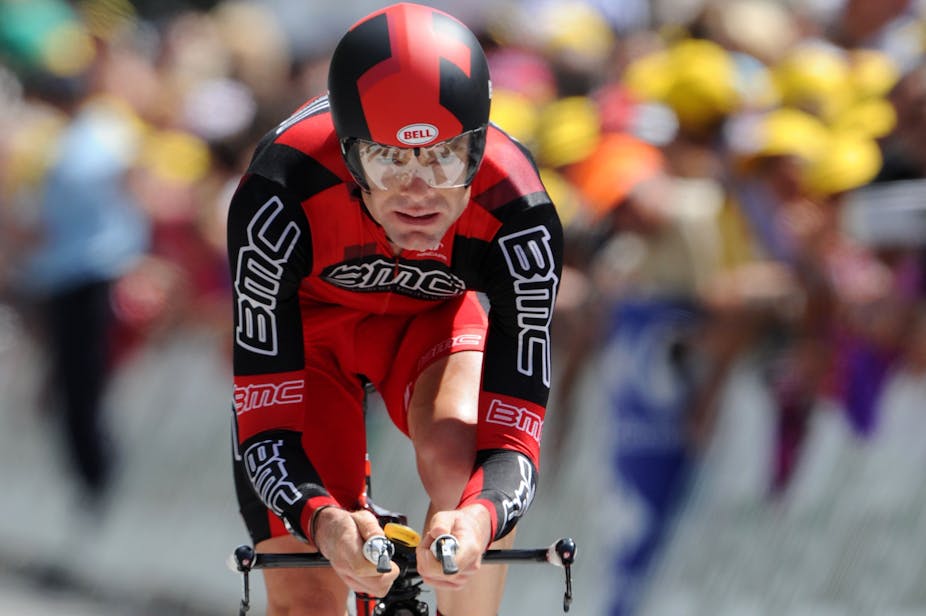Following the 18th stage of the 2011 Tour de France last night, the top six riders are within less than four minutes of one another: Cadel Evans, Andy Schleck, Frank Schleck, Ivan Basso, Damian Cunego and Thomas Voeckler.
If the time gaps between these riders don’t change dramatically after tonight’s short (110 kilometres long) but very challenging (42.4 kilometres of climbing) stage, tomorrow night’s individual time trial (ITT) will decide this year’s Tour.
So, what does the ITT have in store?
The 42.5 kilometre time trial will be held on the streets of Grenoble on the same course from the third stage of this year’s Critérium du Dauphiné Libéré.
That particular race was won by Tony Martin in 55 minutes 27 seconds with an average speed of 46km/h.

Riders in tomorrow night’s ITT will depart at two minute intervals, with the slowest overall rider starting first, and the best-placed rider overall setting off last.
To achieve the best performance during an individual time trial, each rider will have to pay particular attention to the findings of cycling research.
One of the most important factors is the need to reduce drag by striving toward an aerodynamic bike setup. Indeed, a rider will experience considerable performance improvements in a time trial by leaving their standard bike frame, wheels and helmet in the team bus, while also abandoning their usual body position – hands on the “brake hoods” (see image below).

Instead, riders will choose a bike with an aerodynamic frame and wheels while wearing an aerodynamic helmet and trying to keep their elbows on the time trial handlebars (see image below).

The use of aerodynamic equipment and body position will reduce drag, allowing riders to reach higher speeds for a given power output – more than 400 watts for time trial specialists, double what a recreational cyclist could produce for long periods – and consequently decrease their overall time on the 42.5 kilometre-long course.
Nutrition will also have an impact on the power generated by riders during the Grenoble time trial.
Prior to the race, ingesting a small dose of caffeine can allow the riders to obtain a significant improvement (around 5%) on the power that they will be able to produce.
During the race, the riders will also ingest carbohydrate-rich sports drinks – such as Powerade or Gatorade – at regular intervals, allowing them to produce 2-3% more power than if they were drinking water only.
The pacing strategy selected by the riders will also have a significant influence on their final performance.
Interestingly, a rider won’t achieve an optimal performance if he tries to maintain a constant power output throughout the stage. An optimal performance is more likely when a rider is able to vary his power production to reduce speed variations.
Indeed, riders have to constantly adjust their power output to changes in road gradient and wind conditions.
Another important factor of performance during a time trial is the ability of the rider to corner effectively, so as to maintain speed in the bends.
However, trying to gain time in that way can bring a rider to the ground and he can lose his chance of winning Le Tour, as happened to Jan Ulrich when he was fighting against Lance Amstrong in the decisive time trial of the 2003 Tour de France.
Having raced the Critérium du Dauphiné Libéré time trial in June, Cadel Evans will know all about the course, allowing him to define his pacing strategy and to adopt the right cornering trajectories.
Depending on the weather conditions, Evans might beat his time in that particular time trial – 56 minutes 47 seconds – but will that be enough for him to take the Yellow Jersey and ride into the Champs-Élysées as leader of the race?
He certainly has a good chance …
Update: After the epic 19th stage of this year’s Tour de France, Andy Schleck leads the race. His brother Frank is 53 seconds behind and Australia’s Cadel Evans is a further two seconds off the lead.
Further reading

